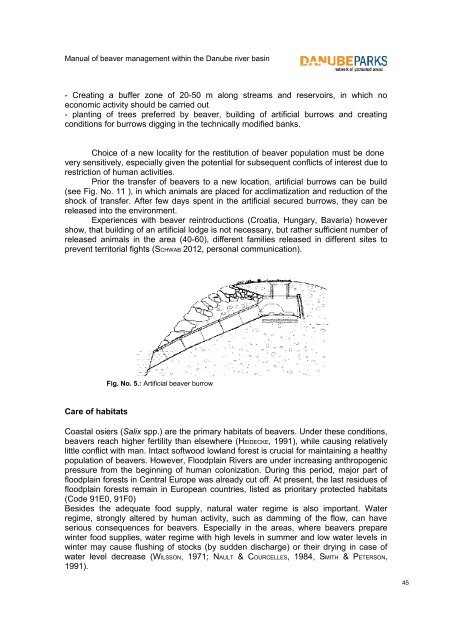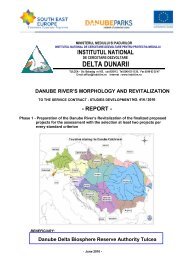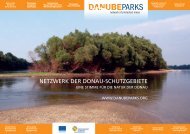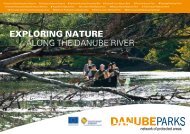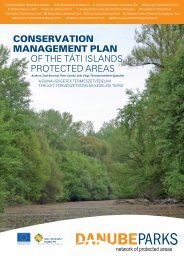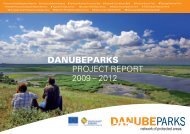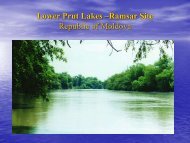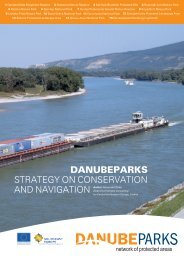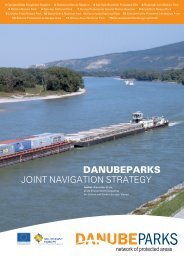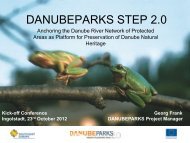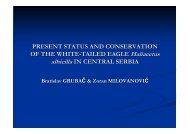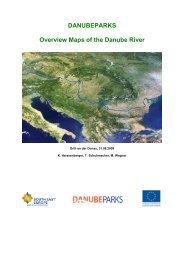Manual of beaver management within the ... - DANUBEPARKS
Manual of beaver management within the ... - DANUBEPARKS
Manual of beaver management within the ... - DANUBEPARKS
- No tags were found...
You also want an ePaper? Increase the reach of your titles
YUMPU automatically turns print PDFs into web optimized ePapers that Google loves.
<strong>Manual</strong> <strong>of</strong> <strong>beaver</strong> <strong>management</strong> <strong>within</strong> <strong>the</strong> Danube river basin- Creating a buffer zone <strong>of</strong> 20-50 m along streams and reservoirs, in which noeconomic activity should be carried out- planting <strong>of</strong> trees preferred by <strong>beaver</strong>, building <strong>of</strong> artificial burrows and creatingconditions for burrows digging in <strong>the</strong> technically modified banks.Choice <strong>of</strong> a new locality for <strong>the</strong> restitution <strong>of</strong> <strong>beaver</strong> population must be donevery sensitively, especially given <strong>the</strong> potential for subsequent conflicts <strong>of</strong> interest due torestriction <strong>of</strong> human activities.Prior <strong>the</strong> transfer <strong>of</strong> <strong>beaver</strong>s to a new location, artificial burrows can be build(see Fig. No. 11 ), in which animals are placed for acclimatization and reduction <strong>of</strong> <strong>the</strong>shock <strong>of</strong> transfer. After few days spent in <strong>the</strong> artificial secured burrows, <strong>the</strong>y can bereleased into <strong>the</strong> environment.Experiences with <strong>beaver</strong> reintroductions (Croatia, Hungary, Bavaria) howevershow, that building <strong>of</strong> an artificial lodge is not necessary, but ra<strong>the</strong>r sufficient number <strong>of</strong>released animals in <strong>the</strong> area (40-60), different families released in different sites toprevent territorial fights (SCHWAB 2012, personal communication).Fig. No. 5.: Artificial <strong>beaver</strong> burrowCare <strong>of</strong> habitatsCoastal osiers (Salix spp.) are <strong>the</strong> primary habitats <strong>of</strong> <strong>beaver</strong>s. Under <strong>the</strong>se conditions,<strong>beaver</strong>s reach higher fertility than elsewhere (HEIDECKE, 1991), while causing relativelylittle conflict with man. Intact s<strong>of</strong>twood lowland forest is crucial for maintaining a healthypopulation <strong>of</strong> <strong>beaver</strong>s. However, Floodplain Rivers are under increasing anthropogenicpressure from <strong>the</strong> beginning <strong>of</strong> human colonization. During this period, major part <strong>of</strong>floodplain forests in Central Europe was already cut <strong>of</strong>f. At present, <strong>the</strong> last residues <strong>of</strong>floodplain forests remain in European countries, listed as prioritary protected habitats(Code 91E0, 91F0)Besides <strong>the</strong> adequate food supply, natural water regime is also important. Waterregime, strongly altered by human activity, such as damming <strong>of</strong> <strong>the</strong> flow, can haveserious consequences for <strong>beaver</strong>s. Especially in <strong>the</strong> areas, where <strong>beaver</strong>s preparewinter food supplies, water regime with high levels in summer and low water levels inwinter may cause flushing <strong>of</strong> stocks (by sudden discharge) or <strong>the</strong>ir drying in case <strong>of</strong>water level decrease (WILSSON, 1971; NAULT & COURCELLES, 1984, SMITH & PETERSON,1991).45


